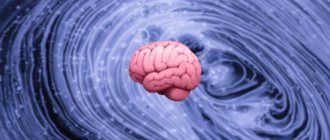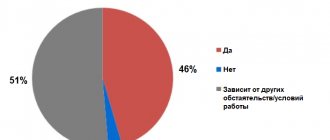There is a lot of material on the Internet about the development of personal growth. Everything seems to be normal, but “nothing happens” that would make us wake up every day with joy and go “with a feeling of flying” to do our favorite thing. And this happens because “life on autopilot” does not suit you, but you don’t know a clear strategy for moving, and where to move. And all because there are no goals and a plan for personal growth when you know “what, why and why” you need to do.
On the walls of the Temple of Apollo in Delphi, an ancient inscription has been preserved: “Know yourself” - this is nothing more than personal growth.
Developing personal growth in the head and body
The time “X” comes and we begin to engage in personal growth and self-development.
Very often we are faced with the fact that we want to change everything. To do this, we begin to take care of ourselves, read a lot of books, go to trainings. And we don’t understand at all why changes in our lives are in no hurry to happen.
There is an expression among psychologists that “the internal tightens the external.” We can only agree with this if we actually do something for these changes.
Self-development always occurs at all levels: in the head and in the body. In other words, the inner always draws out the outer, and not vice versa. Self-development occurs in all areas of life:
- Physical
- Spiritual
- Intelligent
- Emotional
- Creative
What pushes us to change everything that is familiar to us. Yes, exactly, stressful situations that smoothly move from one to another and sometimes do not end at all or end in neurosis. Therefore, this is another reason to think about changes.
And some never come to change. They decided, for example, to reduce weight by 20 kg, but they do nothing at all, they just want to. And so they “waddle” from holiday to holiday, only having the desire to lose weight. Even diseases that are a consequence of excess weight do not stop a person. And he does not strive to start doing something, even in the name of his “health.”
Self-development is still a comprehensive work on oneself. And you need to have the willpower to start doing it.
Why don't people want to develop?
It's not that simple at all. Therefore, people who spend a lot of time reading literature, or endlessly attend trainings, but do nothing on their own, or do not study personally with a coach, remain in their original positions. What are the reasons for all this:
- Lack of willpower
Procrastination or constant putting things off, or simple laziness, prevent a person from moving towards his goals. In some families, parents raised willpower in their children, while in others they did not. But this does not mean at all that you cannot raise her yourself. It's like a muscle, the longer you train, the better the results.
There are two approaches to training willpower: Do OR Don't. Our body will find thousands of reasons not to do it, since it does not want to leave the “comfort zone”. But as we wrote earlier, “if you do everything as always, then you will get the same result as always.”
Start training yourself with daily, constant actions: exercise, church fasts, daily 40-minute walks, maintaining a family budget, monitoring expenses and your free time. You need to make plans and carry them out. Otherwise there will never be a result.
Willpower is a spiritual quality, and it is cultivated by people with very high awareness.
Just by developing this quality you can achieve dramatic changes in your life.
- Lack of motivation
A person needs a very strong desire to motivate himself to change. And as a rule, our inner voice often tells us: “Well, why do you need this? And so good!” And everything remains in the same place. Therefore, a person will never lose his extra 20 kg. Because you need to seriously deny yourself something, spend time on sports, count calories. To limit yourself means to deprive yourself of “sweets”. Who, the one who loves him, would bring himself to this?
In order to have motivation, you need to set the right goals, clearly see and visualize the result of what you want. And only then with willpower and overcoming yourself can you get results. The proverb: “Without labor, you can’t catch a fish out of a pond”... that’s what it’s about!
- Lack of time management
This is another reason that slows people down on the path to their goals. There are plans, but there is no exact time when they will begin to be implemented. And this is a big mistake. Many people try to start “on Monday”, “on New Year”, etc. and they never start. Time is the most valuable resource. So years pass, but “things are still there.”
It’s not enough to plan, it’s also worth tracking the implementation, and giving yourself pluses for completing it, and be sure to encourage yourself.
- Lack of discipline
Here you only need to write one thing: if you have started, then for at least 21 days you should do it every day, without days off, and without excuses. The body “will not help you in any way”; it will even “invent” a disease. But you still try and do it. This is the only way to get results.
LiveInternetLiveInternet
58 facts about the last Russian Emperor Nikolai Alexandrovich and his reign
1. Knew five foreign languages. His brilliant education (higher military and higher legal) was combined with deep religiosity and knowledge of spiritual literature. Served in the army. He had the military rank of colonel. When generals and field marshals persuaded him to grant himself at least the rank of general, he replied: “You, gentlemen, don’t worry about my rank, think about your career.”
2. He was the most athletic Russian Tsar. Since childhood, I regularly did gymnastics, loved to kayak, traveled several tens of kilometers, loved horse racing and participated in such competitions myself. In winter, he enthusiastically played Russian hockey and went skating. He was an excellent swimmer and an avid billiard player. He was fond of tennis.
3. Things and shoes in the royal family were passed from older children to younger ones. The Tsar himself was so modest in his personal life that until his last days he wore his “groom’s” suits.
4. Funds from the London Bank, approximately 4 million rubles (imagine the current equivalent!), left there to him from his father, were spent without a trace on charity.
5. Not a single petition for pardon that reached the Tsar was rejected. During his entire reign, fewer death sentences were handed down and executed than were executed in the USSR per day, until Stalin’s death.
6. The number of prisoners is much less than in the USSR or the Russian Federation. In 1908, per 100,000 people. prisoners - 56 people, in 1940 - 1214 people, in 1949 - 1537 people, in 2011 - 555 people.
7. The number of officials per 100,000 people in 1913 was 163 people. And after a hundred years of life without the Tsar, in 2010 there were 1153 people.
8. In Tobolsk, in prison, the Family did not remain idle for a day; the Emperor chopped wood, cleared snow, and looked after the garden. A peasant soldier, seeing all this, said: “Yes, if you gave him a piece of land, he would earn Russia back for himself with his own hands!”
9. When the temporary workers were preparing an accusation of treason against the Tsar, someone suggested publishing the personal correspondence between Nikolai Alexandrovich and the Empress. To which I received the answer: “It’s impossible, then the people will recognize them as saints!”
10. The Tsar is not to blame for the tragedy on Khodynka. When he found out about this, he immediately provided the dead and injured with great material and moral assistance.
. In 1905, the revolutionaries themselves began to shoot at the troops. And there were 130 dead, not 5,000, as the Russophobe and God-fighter Lenin said. Even those who were wounded in the return fire were provided with immediate medical assistance, and all the victims were taken to the hospital. But the Tsar was not in the city at all that day. When he found out about this, he provided the dead and injured with great material and moral assistance. From his personal funds he paid compensation of 50,000 rubles to each victim. (huge money at that time). In 1905-1907, the revolution was averted thanks to the strong will of the Sovereign.
12. Created the greatest Empire in terms of strength, power and prosperity, which had no equal either before or after him.
13. The Russian Orthodox Church was the most powerful church in the world. By 1913 alone, there were 67 thousand churches and 1 thousand monasteries in the Republic of Ingushetia, spread throughout the entire territory of the Republic of Ingushetia. The Russian Church had enormous influence in the Holy Land, patronizing Orthodox Christians not only in Europe, but also in Asia, and even in Africa.
14. During the 20 years of his reign, the population of Russia increased by 62 million people.
15. I checked the new infantry equipment system personally, during a march of 40 miles. He didn’t tell anyone except the Minister of the Household and the Palace Commandant about this.
16. Reduced his service in the army to 2 years, in the navy to 5 years.
17. During the First World War (World War I), he constantly went to the front, and often with his son. Thus, he showed how much he loves his people, that he is not afraid to die for them and the Russian land. He showed that he is not the least bit afraid of death or anything else. And then, even in the most difficult time for the Russian army, the Tsar took over the Supreme Command of the troops. While the Emperor led the troops, not an inch of land was given to the enemy. Nicholas's troops did not allow Wilhelm's troops to move further than Galicia - Western Little Russia (Ukraine) and Western Belarus, and military historians believe that without internal unrest (revolution) there was one step left before Russia's victory. The prisoners were treated as sufferers. They retained ranks, awards, and monetary allowances. The length of time spent in captivity was counted towards the length of service. From 2 ml. 417 thousand prisoners during the entire war, no more than 5% died.
18. The share of those mobilized in Russia was the smallest - only 39% of all men aged 15-49 years, while in Germany - 81%, in Austria-Hungary - 74%, in France - 79%, England - 50%, Italy - 72%. At the same time, for every thousand of all inhabitants, Russia lost 11 people, Germany - 31, Austria - 18, France - 34, England - 16. Also, Russia was almost the only one that did not experience problems with food. No one in Russia would have dreamed of German “military bread” of the unimaginable composition of the 1917 model.
19. GKZ Bank issued large loans to peasants; by 1914, peasants owned 100% of arable land in Asian Russia, Siberia and 90% in the European part of the country on ownership and lease rights. In Siberia, state-owned warehouses for agricultural equipment were established, supplying the population with agricultural machines.
20. The amount of taxes per person in 1913 in Russia was 2 times less than in France and Germany and more than 4 times lower than in England. The population was stable and rapidly growing rich. The earnings of Russian workers are higher than European earnings, second (in the world) only to American earnings.
21. Since June 1903, entrepreneurs have been obliged to pay benefits and pensions to the injured worker or his family in the amount of 50-66 percent of the victim’s maintenance. In 1906, workers' trade unions were created in the country. The law of June 23, 1912 introduced compulsory insurance of workers against illnesses and accidents in Russia.
22. The social insurance law was adopted first of all European countries and the United States.
23. The most advanced labor legislation in the world. “Your Emperor has created such perfect labor legislation that no democratic state can boast of.” US President William Taft.
24. Prices for everything are among the lowest in the world, along with taxes.
25. Increase in budget volume by more than 3 times.
26. The ruble, thanks to the monetary reform of 1897, began to be backed by gold. “Russia owes its metallic gold circulation exclusively to Emperor Nicholas II.” S. Yu. Witte
27. In 1908, compulsory primary education was introduced. By 1916, at least 85% of the Empire was literate. On the eve of the war there were already more than a hundred universities with 150,000 students. In terms of their total number, RI ranked 3rd in the world, sharing it with Great Britain. Funding for education has grown over 20 years from 25 million rubles to 161 million rubles. And this does not take into account zemstvo schools, expenses for which increased from 70 million in 1894 to 300 million in 1913. In total, the public education budget increased by 628%. The number of students in secondary educational institutions increased from 224 thousand to 700 thousand. The number of students has doubled in 20 years, the number of schoolchildren has grown from 3 million to 6 million people. By 1913 there were 130 thousand schools in the country. Before the revolution, a law was passed on complete free education, not only education, but also life during education. The seminary was completed at government expense - this government account included all the maintenance and meals of the students.
28. In 1898, free medical care was introduced. In order to receive it, it was enough to simply be a citizen of the Empire. No one would have kicked this person out onto the street, as now, and he would also, after a thorough examination, be told in detail what and how to do for treatment. “The medical organization created by the Russian zemstvo was the greatest achievement of our era in the field of social medicine, since it provided free medical care, open to everyone, and also had deep educational significance” Swiss F. Erisman. In terms of the number of doctors, Russia was in 2nd place in Europe and 3rd in the world.
29. Kindergartens, shelters, maternity hospitals, and shelters for the homeless are being built at an unprecedented pace throughout the Empire.
30. Under Nicholas II, Russian nationalism was the most powerful force in legal politics, firmly defending Russian interests wherever we came into contact with enemies. There were many organizations, some parties and all kinds of patriotic movements, from the Union of the Russian People and the All-Russian National Union to local organizations that covered the whole country with a wide network. Where a Russian person could come and tell about his misfortune, ask for help if someone offends him.
31. Industry grew rapidly. From 1890 to 1913, GDP increased 4 times. Coal production has increased 5 times in 20 years, and pig iron smelting has increased 4 times over the same period. Copper and manganese production increased 5 times. Investments in fixed capital of machine-building plants increased by 80% from 1911 to 1914. In 20 years, the length of railways and telegraph networks doubled. During the same time, the already largest river merchant fleet in the world doubled its tonnage. Industrial mechanization grew rapidly. In 1901, the USA produced 9 million 920 thousand tons, and Russia produced 12 million 120 thousand tons of oil. in the period from 1908 to 1913, the growth of labor productivity in industry outstripped the United States, England and Germany, which had long been considered industrial giants. The result of the Tsar's activities was amazing economic stability. During the global economic crisis of 1911-1912, Russia, on the contrary, was on the rise.
32. Under the Tsar, it was impossible to export crude oil abroad, and the proceeds went to the development of domestic industry.
33. In 1914, at the request of the United States, Tsarist Russia sent about 2,000 Russian engineers to the Americans to create a heavy military industry.
34. The growth rate of national income is 1st in the world. The growth rate of labor productivity is 1st in the world. The level of production concentration is 1st in the world. The world's largest exporter of textile products. One of the world's largest manufacturers of non-ferrous and ferrous metallurgy products. One of the world's largest manufacturers of mechanical engineering products. One of the world's largest countries in terms of coal production.
35. The world's largest exporter of grain crops, flax, eggs, milk, butter, meat, sugar, etc. Grain harvests are 1/3 larger than the harvests of Argentina, the USA and Canada combined.
36. Increase in grain production by 2 times. Productivity increased by more than 1.5 times.
37. The number of cattle has increased by 60%. 1st place in the world in the number of horses, cattle, sheep, and one of the first in the number of goats and pigs.
38. Often, without firing a single shot, the following territories joined or became protectorates: Northern Manchuria, Tianjin, Northern Iran, Uriankhai Territory, Galicia, Lvov, Przemysl, Ternopil and Chernivtsi provinces, Western Armenia. Large-scale and rapid development of Siberia, Kazakhstan and the Far East is underway.
39. The sovereign stood outside and above the interests of individual groups and segments of the population. Economic reforms, like the alcohol reforms, were carried out personally by the Tsar. Sometimes even in defiance of the Duma. The author of all the transformations was Nikolai Alexandrovich, despite all existing myths to the contrary.
40. Freedom of the press, freedom of speech; there is as much freedom as there was neither before nor after his reign.
41. The volume of gold reserves is the largest in the world; The Russian gold ruble is the hardest currency in the world, even to this day.
42. One of the highest rates of railway construction in the world (the USSR never came close to them).
43. One of the strongest armies in the world, which, moreover, is developing rapidly. The best Mosin rifles in the world, one of the best Maxim machine guns in the world from 1910, modified by the Russian Empire; and some of the best 76mm field guns in the world.
44. The Russian Air Force, which was born only in 1910, already had 263 aircraft and was the largest aviation fleet in the world. By the autumn of 1917, the number of aircraft had increased to 700.
45. By 1917 the Navy was one of the strongest in the world. The world's best destroyers and some of the world's best battleships, the world's best mines and mine laying tactics.
46. The Great Siberian Railway was built.
47. The Hague International Court is the brainchild of Nicholas II.
48. Alcohol consumption per capita is one of the lowest in the world; in Europe, only Norway drank less.
49. The number of mentally ill people per 100,000 people in 1913 was 187 people. And after a hundred years of life without the Tsar, in 2010 - 5598 people.
50. The number of suicides per 100,000 people in 1912 was 4.4. And after a hundred years of life without the Tsar, in 2009-29.
51. There are no problems with inflation and unemployment, since both are almost completely absent.
52. The crime rate is lower than in the USA and Western European countries. At an international congress of criminologists held in 1913 in Switzerland, the Russian detective police were recognized as the best in the world in solving crimes.
53. An unprecedented flowering of Russian culture. No other country has known such a powerful, dizzying rise of Russian painting, Russian architectural architecture, Russian literature and Russian music. The famous French writer and literary critic Paul Valéry called Russian culture of the early twentieth century “one of the wonders of the world.”
54. The heyday of Russian philosophy and science.
55. Invented for the first time in the world: wireless telegraph, helicopter and bomber, television and television broadcasting, airplane and attack aircraft, the first newsreel, tram, hydroelectric power station, electric plow, submarine, backpack parachute, radio, cathode ray tube, electron microscope, machine gun, powder fire extinguisher, astronomical clock, electromagnetic seismograph and the science of seismology was founded, electric car, electric omnibus, electric cable car, underwater minelayer, seaplane, ship capable of overcoming Arctic ice, one of the first to find a way to take color photographs and the first in the world to learn how to make them of high quality.
56. Invented for the first time in Russia: a car, a motorcycle, a double-decker carriage, an airship.
57. The automobile industry was at the German level, the aviation industry was at the American level, some of the best steam locomotives in the world. The Russo-Balt series of cars, produced since 1909, was world class, both in design and performance. They were distinguished by their durability and reliability, as evidenced by their success in rallies and long-distance runs, in particular at the international rallies of Monte Carlo and San Sebastian.
58. Two of the five founders of Hollywood came from Russia. The famous fragrance “Chanel No. 5” was not invented by Coco Chanel, but by the Russian emigrant perfumer Verigin. The engines were developed by Russian engineer Boris Lutskoy. The racing Mercedes 120PS (1906) was equipped with an in-line six-cylinder engine, also invented by Lutsky.
59. All this was done and achieved without: terror, dispossession (plunder) of peasants, slave camps, tens of millions of exterminated Russian people.
60. He never abdicated the throne, even despite the colossal betrayal of everyone and everything. As he himself wrote: “There is treason and cowardice and deception all around!” As a result, he was ritually killed along with his family. (Without leaving his homeland. Although he could easily go abroad and live happily).
The conspirators drew up a fake manifesto, supposedly his renunciation, which is a complete fake. In the archives of the Russian Federation there is not a single document confirming the correctness of the myth of renunciation. There is a printed piece of paper, signed in pencil, composed incomprehensibly. There is not a single other document that Nikolai signed in pencil. The handwriting was also examined, which absolutely does not correspond to the handwriting of the Sovereign. There are still too many other troubles.
Source: Victor Voroshilov Facebook
What is personal growth and self-development?
American psychologist Carl Rogers in 1959 answered the question of what human personal growth is. He identified the general “law of personal growth” based on the “if-then” formula. It sounds like this: if the necessary conditions exist, then the process of self-development is actualized in a person, that is, changes aimed at his personal maturity.
- It is a constant and never-ending process of learning something.
- Thanks to this, a person grows and develops both qualitatively and quantitatively, noticeable changes occur
- Knows yourself better and improves your personal qualities
- Gains new skills and finds his purpose
- Improves quality of life and lives more consciously and interestingly
- Life becomes more harmonious, and this makes it joyful and happy
This is, in fact, the most profitable investment - an investment in your self-development, personal growth.
Growth is always quantitative changes that a person can track himself, and development is qualitative changes; as a rule, the environment takes part here.
What gives a person personal growth?
- Get out of stress
- Financial stability
- Recovery from depression and nervousness (from illness)
- Relationships normalize, it happens that people next to you begin to grow or leave
- Getting rid of addiction
- Marriage
- Feeling good
The development of personal growth first of all changes a person’s consciousness. If, for example, he wanted to lose weight and couldn’t, then first of all he changed a lot of existing attitudes in his head to others (psychological ways of influencing his body). Physically changed my habits, started eating healthy and adjusted my lifestyle. Time needs to pass. And only then can you count on results.
How psychology affects physiology
The starting point is always in your head. Analysis of events can be carried out independently or better with a psychologist. Each time you delve into “adverse events,” you can become completely bogged down in them. And not only fail to pull yourself out of stress, but, on the contrary, get even more bogged down.
Therefore, it is better to do all this with a psychologist who will competently guide you through all the labyrinths of your memory and help you correctly adjust these settings.
Periodization of the human life cycle
Age characteristics determine specific periods of formation and development of a person’s mental, anatomical and physiological qualities.
In human ontogenesis, the following main periods are distinguished: 1st - intrauterine, or prenatal: from the moment of conception to birth; 2nd - postnatal: from birth to death of the individual. Each of them includes special, very important cycles of development of the human individual.
This is a complete periodization of development, and a partial one includes that part of it that is of interest to a specific science. Any of the human science disciplines is based on scientific data, defining the boundaries of a particular life cycle of an individual. The discrepancies are explained by the peculiarities of the subject of periodization itself: in psychology it is the development of mental processes, in pedagogy it is the process of socialization of the individual, taking into account the stages of his psychophysiological maturation.
How to change yourself
- You need to change your thoughts.
Reading books and working with a psychologist, you can remain in a state for a long time that “everything is clear.” But you also need to take and take action regarding these changes yourself. You don't need to think, but do everything physically.
- You can't do without positivity
Everything you do must be done with a positive attitude. If every time you say that “I can’t”, “I can’t do this”, “this is hard”, then you will never move forward. A positive attitude and desire are required. Be sure to monitor your negative thoughts and change them into a positive mindset.
However, we should understand that not everything will work out the way we want. Something will not go at all as we planned. But even in this case, you shouldn’t despair and give up everything. We need to move on.
What do I want to change by engaging in self-development and personal growth?
It's worth asking yourself a few questions:
- What do I want to start doing?
For example, learn to swim or ride a bike. Or maybe learn to set goals and plan.
- What do I want to stop doing?
For example, working at a job you don’t like, or maybe smoking, engaging in idle pastimes and watching endless TV series.
- What would you like to buy?
Some people want to acquire new skills, others want to find a new job and improve their income. Or maybe you want something material. It is worth thinking carefully about this issue.
- What do I want to change in my life?
For example, place of residence, or maybe country of residence. Lifestyle, gain financial freedom or monetize your hobby.
Neural connections and self-talk
New neural connections do not appear immediately. You need to work on them. Therefore, there must be new skills and new knowledge to know how to change everything. Physiologically, the body and head must get used to these changes.
And to understand that they are good for you, you must be calm and happy. And here, too, you can use the technique of “talking to yourself.” About the fact that “it’s like this for now, but everything is moving towards a better, more profitable and more fun life.”
Any habit takes root within three weeks or a month. Therefore, do not sabotage, but simply gradually introduce this habit into action. Soon it will become your reliable support on the path to change. For example, repeating a new habit over and over again will reinforce it in your brain.
Talking to yourself
Endogenous factors
The unevenness and asynchrony of development and growth of different organs of the human body and individuals during the juvenile period are explained by several reasons:
- dependence on the individual’s gender;
- heredity;
- influence of the surrounding natural and social environment.
Hereditary factors, or endogenous ones, determine the appearance (family resemblance, national characteristics) of a person, his physique, and the pace of ontogenetic development. Signs of genetic inheritance can appear at different stages of ontogenesis, but decrease during puberty.
Advice from a neuroscientist
The famous neuroscientist Wendy Suzuki (her book is on our RECOMMENDED page) suggests changing psychology by reinforcing it with physiology. To do this, she and her students engage in sports exercises during a lecture on neurobiology. For example, the following interesting conclusions can be drawn from her work:
- Any physical exercise, and especially its repetition, increases the release of positive neurotransmitters (pleasure hormones in this case) in the head. These hormones immediately improve your mood, and last two hours after training, and even your reaction time improves. The same can be said about race walking at a speed of 4.5-5 km per hour.
- Once you begin to exercise regularly and physically train your body, your memory improves and new neural connections appear. This means that the rest of your brain cells undergo these changes. Of course, treating Alzheimer's disease and memory loss is difficult. But it is possible to improve the consequences of senile dementia.
- You don’t have to go to the gym; you can walk in the park at a sporting speed 3-4 times a week for just 30-40 minutes to train your heart muscle. In addition, if you add useful affirmations, your well-being will improve significantly.
And then you will definitely understand the difference between the word I want and the word I really feel. Summing up, in order to see changes when practicing self-development, you need to do everything consciously and physically, and then there will definitely be personal growth!
Join us on the Yandex.Zen channel










